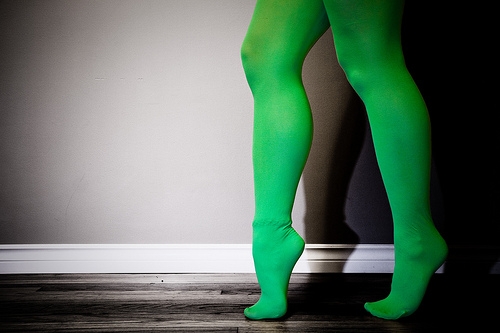Send your question to Umbra!
Q. Dear Umbra,
Back-to-school shopping season is fast approaching, and item No. 1 on the list is a few new pairs of tights for the winter months. Problem is, almost every pair I bought last year ripped after two or three wearings. I understand these things aren’t made to last forever, but I don’t want to throw out so much clothing (and money!) again this year. Do you have any brands you recommend that are more durable and sustainable? Any ways to repair or reuse torn nylons?
Patricia W.
Naperville, Ill.

Photo by Alison Faith.
A. Dearest Patricia,
I can hear my editor now: “You answered a question about tights? What’s green about that?” Not much, editor. You have a fine, albeit imaginary, point. But this mention of back-to-school shopping reminds me that we should all be thinking about Being Wiser Consumers. (Psst, Patricia: If you want my actual advice about tights, consider skipping the next few paragraphs.)
Back-to-school season is traditionally the second-most lucrative for U.S. retailers, after the winter holidays. Although sales are flagging a bit this year, Americans are expected to spend more than $80 billion getting ourselves and our family members ready for school: $30 billion on kids at home, and a cool $53.5 billion on the college-bound (must be all those laptops). If you feel like back-to-school season is arriving earlier than ever, you’re not imagining things: Skittish about the economy, retailers have been extending the season the last couple of years, some even advertising before school lets out in June.
Do we really need all the things they’re pushing? One article on this year’s sales slump cited a penny-pinching parent who “plans to reuse her kids’ backpacks.” Do you mean to tell me those children are otherwise getting a new backpack every August? Have we all gone insane?
Let me be clear: I am not opposed to spending money, getting the economy going again, supporting businesses — especially local ones — or even looking nice in public. I was once a third-grader who wanted stripy shoes. But I do get spitting mad when I think about planned obsolescence, cruddily made products, and the oft-cited notion that buying more makes us better citizens. I encourage everyone to pause a moment before loading up on “must-haves” this month. The real must-have is common sense.
OK, Patricia, my rant is done, and I do have a few ideas for you:
- Love the ones you’re with. Can you repair your ripped tights? I’m a fan of making things last as long as possible. I’m sure you know the nail-polish trick for stopping (or at least slowing) a run in hosiery. Another trick I’ve heard, but never tested, is to strengthen new tights and stockings by freezing them. Here are a few other tips for making tights last and making small repairs, from a site whose banner is truly worth a peek. The long and short of it: Wear the right size, and handle your tights and yourself with care.
- Shop sustainably. If you decide to buy new tights and you can invest a bit upfront, you might consider looking into pairs made with materials like bamboo, organic cotton, and hemp. They should last longer, plus their production is a bit less planet-destroying. Since one of your primary goals is warmth, I’d also recommend looking into some of the sustainable leggings and long underwear out there — they’re not like their bulky, itchy counterparts of old.
- Reuse them. For tights or nylons that are beyond repair, I refer you to this list of 20 reuses, which has won my affection by not being presented in slideshow format, and contains creative suggestions from wrapping-paper storage to plant protection. Readers, I’m sure you have other ideas — please weigh in.
Finally, because this is the real world and we can’t all splurge on $25 hemp tights, I’m going to break my usual rule of not recommending brands and suggest you check out one you’ve heard of but perhaps not given much thought to: No Nonsense. They make 95 percent of their products in the U.S., have taken steps to green their facilities and materials, and donate socks to needy families. Best of all, they run a first-of-its-kind pantyhose recycling program — they take tights too, and any brand — which converts your gam-garments into playground equipment, park benches, toys, and other products.
Upcycling an item that would otherwise linger in the landfill? Now that’s a must-have.
Stretchily,
Umbra


